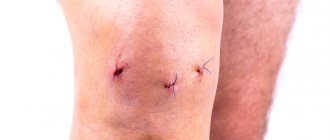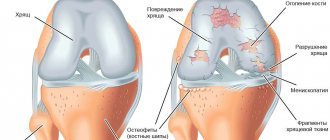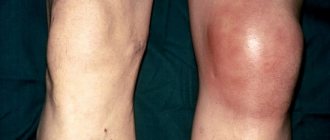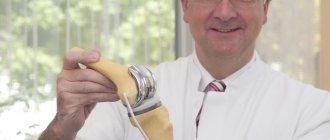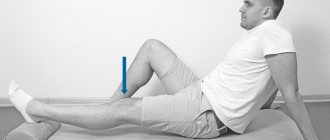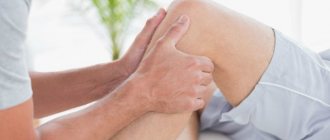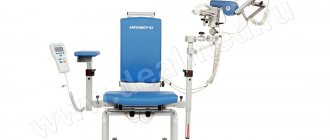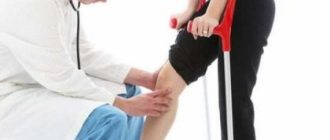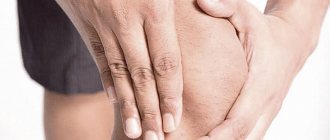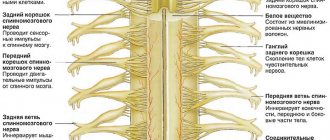What is the importance of developing the knee during rehabilitation?
The need to develop the knee joint after a long period of immobility is explained simply. Immobilization of the joint leads to impaired blood circulation in the limb, rapid muscle atrophy, shortening and drying out. In the absence of passive movements, damaged ligaments scar and thicken, and the tendons tighten. Contracture develops.
The purpose of developing the knee joint is:
- restoration of the damaged joint to the “pre-injury” level;
- regaining the ability to fully move and care for oneself;
- improving quality of life.
The sooner rehabilitation actions are started, the sooner the patient will be able to develop the knee and return to active life. If there is a delay in using the joint, the limb will no longer bend or straighten completely, adhesions will appear between the ligaments and nearby tissues, and contracture will develop. The patient may require surgery to remove fibrous bands.
Types of techniques
Rehabilitation after knee replacement or fracture should begin as early as possible. Passive recovery should begin within the first 36–48 hours after surgery. Equally important are phased, individual approach and comprehensive development.
There are several methods of knee rehabilitation:
- physiotherapy;
- massage;
- physiotherapy;
- mechanotherapy.
With all the abundance of rehabilitation techniques, gymnastics is considered the basis for developing the knee joint. The remaining techniques are additional and should be carried out on the recommendation and under the supervision of a doctor. This multidisciplinary nature of treatment allows you to quickly get rid of pain and contracture and completely restore lost functions in 2–3 months.
You can develop your knee joint with physical therapy at home. The main thing is to regularly perform the recommended complex and monitor your well-being.
For patients wearing a cast
At this stage, it is recommended to perform gymnastics to generally strengthen the upper shoulder girdle. Lying straight in bed, the patient can straighten and bend the uninjured leg, perform abductions and lifts, and also strain the muscles in a static manner. Weak movements can also be performed with healthy parts of the injured leg, for example, with the fingers, thus avoiding blood stagnation and severe swelling.
Already two or three days after a cast is applied to the leg, doctors advise performing the following simple set of exercises:
- Slowly pull your chin towards your chest and then move it back;
- Place your hands behind your head and grab the headboard. Pull your body up in the back, then return to the starting position;
- Raise and lower your arms vertically in front of you. Over time, you can take dumbbells or regular bottles filled with water;
- The healthy leg can be pulled towards you and then straightened. It is important not to lift your foot off the bed while performing the exercise.
Exercises for knee rehabilitation
It is important that in the process of developing the knee joint, the stages of movements are observed, i.e. you need to start with a minimum load, gradually moving on to more complex exercises.
You can learn how to perform gymnastics correctly after a knee fracture in a physical therapy room under the guidance of an instructor, or ask your doctor what is permissible to do immediately after surgery. These are usually simple movements that involve tensing the muscles and using your own body weight.
All movements for developing the knee joint are usually classified into three groups: immobilization, post-immobilization and recovery. You can do the exercises either using additional weight or using exercise machines and orthopedic mechanisms.
During the rehabilitation period
Physical rehabilitation after a knee fracture is aimed at improving joint mobility, developing the flexibility of ligaments and tendons, strengthening muscle fibers, and renewing motor skills. General developmental movements are supplemented with hardware procedures, swimming, race walking, and exercise equipment.
There are several sets of physical exercises focused on knee rehabilitation. For example, after a fracture of the kneecap or hip joint, the treatment complex is selected in such a way as to improve blood supply to the injured joint, restore the patient’s strength and strengthen the muscles. If the bones of the hip or patella are damaged, it is recommended to use race walking, exercise equipment, and swimming.
It should be noted that the recovery period after a fracture of the kneecap is always difficult and long. The following exercises will help speed up development:
- From a sitting position on the floor, legs extended. Lean forward and try to touch your forehead to your knees.
- Standing, with support on a horizontal surface. Perform light, springy squats.
- Sitting on a chair. Take turns straightening your legs at the knees.
It is recommended to perform the movements twice a day, 10–15 times each. If your physical condition allows, you can do several approaches.
A set of therapeutic exercises for the rehabilitation of the knee joint is well complemented by “riding” an exercise bike. Such exercises perfectly develop joints, gently stretch and strengthen ligaments, and tone muscles. The first workouts should not exceed 10 minutes, then the time can be increased to half an hour. In order to maintain overall health, exercise therapy to develop the knee joint must be supplemented with exercises for the healthy leg and upper body.
After surgery
Photo from the site medaboutme.ru
You do not need to do any active movements for the entire first week after surgery. To prevent postoperative complications and improve blood supply, breathing exercises are performed, and therapeutic positioning (giving different poses) of the limb is useful. Antigravity exercises are prescribed.
After you feel better and have strength, you are allowed to start a lighter version of exercise therapy to develop the knee joint:
- Lift the operated leg off the bed, lift it 20 cm and hold it there for 5–10 seconds.
- Tighten the muscles of the thighs and buttocks. On the count of twelve, relax.
- Lying on your back, place a rolled blanket under the foot of the injured leg and apply pressure to it. After 10 seconds, rest.
- Lying down, with your limbs straight, slowly spread your legs to the sides and return them back.
All movements considered should be performed 10–12 times twice a day. After a week, they are replaced with more complex ones, which help quickly develop the knee joint. If the patient is already allowed to stand up after surgery, it is recommended to do them standing or sitting:
- Place two chairs. Sit on one, put your leg on the other, resting on your foot. Relax and allow the knee joint to sag.
- Another variation of this exercise: at the moment of full extension of the joint, the assistant should carefully remove the chair. The patient needs to hold the limb suspended for at least 5 seconds.
- While standing, raise the affected leg at an angle of 45°, hold it in weight and lower it.
Working out the knee joint using a rubber bandage has a good effect. Lying down, you need to bend the operated limb at the knee as far as possible, hook the expander onto your foot and pull it towards you. Repeat this 7-10 times.
After removing the plaster cast
The following set of movements is designed to develop the knee after removing the cast:
- Standing, feet shoulder-width apart. Bend one limb, leaning on the other.
- Standing near a chair, do half squats.
- From the same starting position, lunge forward, changing legs. It is advisable to hold on to support.
- Lying on the floor. Bend the affected limb at the knee joint, throw the expander over the ankle and pull the leg towards the thigh without lifting the heel from the surface of the bed.
- Walk up the stairs, starting with the affected limb.
To develop your knee, it’s good to climb a wall bars or climb a rope. If there is no pain in the joint and the muscles are sufficiently stretched, you can try sitting on your heels from a standing position on all fours. The movement is difficult, but you have to strive to do it.
The described physical education complex is also suitable for patients who need to develop their knee after a complex hip fracture. Prolonged immobilization weakens the legs and impairs the flexibility of the joints, especially the knee. Therefore, during the recovery period it is necessary to actively restore mobility to this joint.
Main stages of rehabilitation
There are three main stages of rehabilitation treatment after a fracture of the patella, directly related to the timing of immobilization. For each period, certain types of exercises are suitable to promote rapid recovery of the leg.
- Stage 1 – immobilization. It usually begins 2 days after the injury and can last up to 6 weeks. At this time, the person is forced to be in a splint that completely fixes the entire leg. The length of time to wear a splint depends on the characteristics of the damage to the knee joint, whether surgery was performed or not, and also on the rate of bone healing.
Note!
Bone fragments take longer to heal in old age, with excess body weight, with non-compliance with a gentle motor regimen during treatment of a fracture, and in the case of certain chronic diseases (diabetes mellitus, anemia).
At the initial stage, only the simplest exercises for the foot and gluteal muscles are allowed to prevent their atrophy.
- Stage 2 – post-immobilization. During this period, the patient is allowed to remove the splint, he can move the affected leg, but he cannot yet lean on it. At this time, the motor mode expands. Some exercises in a sitting or lying position, active and passive movements become available to the patient.
- Stage 3 – late rehabilitation. This stage begins from the time when the patient can already begin to walk. At first he moves with the help of crutches, but gradually the supporting function of the limb is restored, and the motor range expands. During this period, it is allowed to perform tasks in a standing position, gradually complicating them.
Contraindications
Gymnastics for developing the knee joint after a fracture does not involve taking medications and is more of a preventive nature. Despite this, exercise therapy has a number of contraindications for implementation.
You should not do a set of exercises to develop the knee joint in the following cases:
- persistent pain in the knee, indicating the presence of an inflammatory process;
- a sharp deterioration in health;
- the appearance of bleeding during movements;
- fever, exacerbation of chronic diseases.
Developing a knee after a fracture should be done with an eye to the sensations. You cannot overcome the threshold of your own pain, it is unacceptable to overload the joint, thinking that this will speed up rehabilitation. Just the opposite. Excessive stress will cause swelling and pain, which will inhibit tissue healing and increase the time it takes for bones to heal.
Why develop a knee
Muscles and ligaments become noticeably weaker as a result of prolonged immobilization. Some people complain that the leg does not bend completely after a fracture, or that pain is felt while walking. This is why a proper recovery period is very important.
When wearing a cast, significant changes occur in the joint. There, blood circulation can slow down significantly, and metabolic processes can worsen.
Such symptoms provoke a risk of tendon and muscle atrophy, which is the cause of incomplete extension of the legs.
Massage
Massage will help to develop your knee faster after a fracture and removal of the plaster. It is prescribed from the second week, 1 time per day. The procedure activates blood flow, relaxes and restores elasticity to muscles, warms up ligaments, eliminates swelling and pain.
It is better if the massage is performed by an experienced specialist. But if you don’t have one or if other difficulties arise, you can do the massage yourself. All movements should be performed gently and carefully, moving from bottom to top.
The procedure begins by stroking the ankle. Then it is kneaded and raised along the calf muscle to the knee. Do not press or rub the cup or bone tissue. It is necessary to act only on the periarticular ligaments and move along the thigh to the groin.
Additional rehabilitation methods
Physiotherapeutic procedures help to significantly speed up the recovery process:
- Magnetotherapy reduces pain, muscle spasms, dilates blood vessels, improving the delivery of oxygen and nutrients to damaged tissues, activating regeneration processes.
- The effect of electrophoresis depends on what substance is introduced into the body with its help. In case of severe pain, the procedure is carried out with lidocaine, and at the stage of callus formation - with calcium preparations.
- UHF also helps reduce the severity of pain. This technique can be used already on the second day after injury.
- Laser therapy helps speed up metabolic processes in the patella area, reduce local inflammation and swelling of the tissue.
- UVB is usually used in later stages of rehabilitation. Ultraviolet irradiation helps expand and activate blood flow in the smallest vessels of the knee, restoring adequate blood flow in the injured area.
- Massage after a fracture of the patella is performed in a gentle manner, moving along the leg from top to bottom. First, the thigh is massaged using classical methods of influence - rubbing, kneading, stroking, vibration. They pass from the hip directly to the knee joint. It is not the patella itself that needs to be kneaded, but the soft periarticular structures - ligaments, muscles, tendons. At the end, massage the shin along the front and back surfaces. Massage also stimulates blood flow, lymph outflow, reduces swelling and normalizes the functioning of nerve fibers damaged during injury.
- Manual therapy is the use of hands on joints, muscles, and ligaments. It is carried out after the cessation of immobilization and is aimed at restoring the usual motor activity of the leg. A softer technique is osteopathy, which involves only a slight displacement of soft tissues relative to each other. The risk of complications with this intervention is minimal.
- Acupuncture is considered a safe and effective technique - placing special thin needles in biologically active points. The needles act on the nerve endings, restoring sensitivity and normal innervation to the muscles of the thigh and lower leg.
After a patellar fracture, it is especially important to start treatment in a timely manner and take a comprehensive approach to the problem. The use of several rehabilitation techniques will affect different recovery mechanisms simultaneously and will help you return to your normal life as quickly as possible.
Physiotherapeutic procedures
Photo from the site ponchikov.net
Methods of physiotherapeutic development of the knee joint are considered to be auxiliary means of recovery. Treatment is prescribed at an early stage of rehabilitation, when it is necessary to relieve pain after a fracture and prepare the limb for development. For this purpose, they most often use:
- electrophoresis with anesthetics;
- magnetic therapy;
- UHF;
- laser therapy.
Applications with paraffin or ozokerite will help to develop the knee and quickly cope with swelling. The procedure moderately warms the deep tissues, helping to dilate blood vessels and reduce pain. As a result, nutrition of the injured area is improved and healing is accelerated.
Hardware therapy
A good complement to exercise therapy and physiotherapy is hardware development of the knee, used after the removal of the plaster. It is carried out using special mechanisms that provide passive load on the leg and improve the mobility of the joint.
This method of therapy is intended for early recovery of the knee joint and prevention of the development of thromboembolic consequences. Some devices can be used almost immediately after surgery. For example, the ARTROMOT movement simulator is installed directly on the patient’s bed.
Other mechanotherapeutic devices that help develop the knee joint:
- a treadmill that moves by electricity or by the efforts of the patient himself;
- simulator of walking and climbing stairs;
- exercise bike;
- device for flexion/extension of the knee joint.
Development on motor mechanisms is necessary when conventional gymnastics causes pain or does not produce results. To get the effect, it is enough to complete a course of 15 procedures. The duration of one session is 30 minutes.
Contraindications to mechanotherapy:
- muscle atrophy, which does not allow the patient to overcome the resistance force of the device;
- acute inflammation in the joint;
- contracture caused by deformation of the articular surfaces.
Passive development of the knee joint is also not allowed in case of insufficiently expressed bone callus, the presence of infectious processes in neighboring tissues, or fever.
SRM therapy
Such events are carried out on the basis of special devices. Knee development using the CRM technique is especially recommended in cases where the patient experiences severe pain when bending the legs. The exercises are passive, the patient does not get tired, since the muscles located around the knee are not used at all.
CPM therapy is the best method for developing the knee at the very beginning of the rehabilitation period, when the patient has just had the cast removed and is not able to actively move independently.
The medical specialist selects the parameters of the device individually for each patient. The speed of leg movement and amplitude are adjustable. Stretching of the tissue occurs smoothly and in doses, while the calf and thigh muscles are not strained.
The result of such training is an increase in blood flow to the muscles and joints and a decrease in swelling. The pain also gradually goes away and healthy mobility resumes.
How to develop a knee at home
You can develop your knee joint after an injury or surgery at home. True, in this case, the patient will only have access to physical exercises and some exercise equipment, but with a regular approach, these will be sufficient. Daily efforts will prevent contracture and restore flexibility and mobility to the joint.
Before you start working out your knee yourself, you need to warm up the joint. At first, warm water will be a good helper - you can simply water your leg with a hose for 5-10 minutes. In the future, when the joint becomes more flexible and the ligaments stretch a little, a light massage and a few warming movements will be enough.
Exercises for self-development of the knee joint are similar to those recommended for exercise therapy rooms. These are all kinds of squats and half-squats, knee bending/extension, walking up the stairs. The use of an expander and exercise on an exercise bike has a good effect. If time permits, you can “ride” a bicycle twice a day for 30 minutes.
Another effective way to develop your knee joint at home is by going to the pool. You can enroll in a special health group or go individually. The main thing is to do this regularly and persistently. Daily walking in a quiet place gives good results.
Developing a knee joint is a long and arduous process. The patient must prepare for long months of hard work and daily activities. Only then will the joint return to normal and work as before. Well, if you are lazy and neglect classes, the “reward” will be lifelong lameness.
Author: Elena Medvedeva, doctor, especially for Ortopediya.pro
Isometric training
Such exercises are exercises during which the patient’s joints remain motionless, as well as the length of the muscles. It is necessary to “freeze” correctly in the indicated positions for some time, thus toning your body, strengthening muscle mass, and also developing overall endurance.
Isometric complexes are recommended initially after removing the cast, until the knee cannot be fully extended or severe pain is felt.
- The exercises are performed lying on your back. The arms lie along the body, the legs are straight.
- "Frozen knee." You should tense the front surface of the thigh, simulating extension of the joint.
- “Revitalizing the knee.” Place a cushion under your knee (you can use a towel). Raise your legs straight, lifting your heels completely off the surface. It is important to pull your feet towards you in the process. Every day the roller should be larger, thereby increasing the load level.
- Sit on a high table so that your legs are elevated.
- Straighten the sore leg, hold it at the highest point, and then bend it back.
- Press your heels firmly into the legs of the chair, simulating the desire to bend your knees.
Each of the proposed exercises should be performed up to five times in two approaches. In this case, the point of maximum tension must be maintained for about 20-30 seconds.
Useful video about developing the knee joint
List of sources:
- Contractures. Per. from English N. D. Firsovoy / Christian A., Hanna A., Kim R. // 2021. Rehabilitation after fractures and injuries / Sharov D. V., Ivanyuk A. S., 2002.
- Therapeutic physical education and massage: Educational manual for medical workers / Belaya N. A. // M.: Soviet Sport, 2004.
- Exercise therapy: Textbook for universities. / Epifanov V. A // M.: Geotar-med, 2002.
- Guidelines for the rehabilitation of patients with movement disorders. / Belova A. N., Shchepetova O. N. // St. Petersburg: Academy, 2012.
There are no similar articles.

